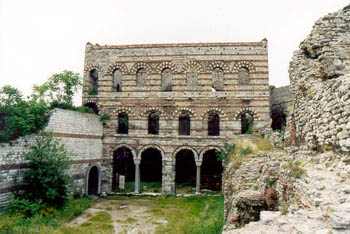TEKFUR PALACE
 Tekfur Palace is a rare and outstanding
example of Byzantine palace architecture, situated just within Istanbuls city walls
near Edirnekapısı gate. Although a large number of superb Byzantine buildings have been
preserved in Turkey, Greece and Italy, these are almost without exception churches or
monasteries. The fear of God and religious sentiments prompted societies to protect and
repair sacral buildings, enabling them to survive intact to the present day. Tekfur Palace is a rare and outstanding
example of Byzantine palace architecture, situated just within Istanbuls city walls
near Edirnekapısı gate. Although a large number of superb Byzantine buildings have been
preserved in Turkey, Greece and Italy, these are almost without exception churches or
monasteries. The fear of God and religious sentiments prompted societies to protect and
repair sacral buildings, enabling them to survive intact to the present day.
No such safeguard applied to palaces and houses, however. What is more, styles of
palace architecture were condemned to frequent change, because society was in a constant
state of flux and requirements and tastes did not remain constant. The palace was a symbol
of power and financial clout, and monarchs were often too proud to live in palaces built
by their predecessors. That is why we find so many churches of a great age, but so few
palaces and houses.
Tekfur Palace is such a rarity. Yet precious as it might be, hardly anything is known
about it, despite the interest in Byzantine history and culture in the West particularly.
Literature on the subject provides very little information about the secular Byzantine
buildings of Istanbul.
The Commenus dynasty is known to have settled in this section of the city, and Alexius
Commenus I to have constructed a magnificent palace on the site of the present
İvaz Efendi Mosque. Manuel II Commenus added another building, turning the palace into a
complex known as the palaces of Blachernae. There is no doubt that Tekfur Palace is part
of this complex. Even reduced to a shell over the centuries, we can see that this three
storey building was striking and beautiful. There are six windows on the ground floor
looking onto what was once a courtyard, and windows on all four façades of the third
floor, which would have commanded a spectacular view over the city and the Golden Horn to
the north, and the countryside and forests to the west. Indeed that green landscape still
existed until the 1950s. There was evidently a chapel on the upper floor, its location
indicated by an apse in the form of a bay.
 The façades are elaborately decorated with
geometric designs in red brick and white stone. The massive stone section flanked by two
splendid marble columns in the façade overlooking the courtyard forms the monumental
entrance. The word tekfur was the Turkish term for the Byzantine emperors, who
were their neighbors until the conquest. During Ottoman times the long abandoned Tekfur
Palace was used first as a menagerie housing strange beasts from distant Africa, and in
the 18th century as a pottery producing tiles. Since then it has remained empty. Ensuring
that Tekfur Palace is preserved for future generations requires that the four walls be
prevented from collapsing and discrete repairs carried out to the stone and brick walls.
Some years ago Istanbul municipality proposed reconstructing wooden floors, but I believe
that this would spoil the atmosphere and character of the palace. Ideally the ravages of
time should be accepted and the walls should be left as they are, perhaps constructing a
glass roof to protect the structure from snow and rain. The façades are elaborately decorated with
geometric designs in red brick and white stone. The massive stone section flanked by two
splendid marble columns in the façade overlooking the courtyard forms the monumental
entrance. The word tekfur was the Turkish term for the Byzantine emperors, who
were their neighbors until the conquest. During Ottoman times the long abandoned Tekfur
Palace was used first as a menagerie housing strange beasts from distant Africa, and in
the 18th century as a pottery producing tiles. Since then it has remained empty. Ensuring
that Tekfur Palace is preserved for future generations requires that the four walls be
prevented from collapsing and discrete repairs carried out to the stone and brick walls.
Some years ago Istanbul municipality proposed reconstructing wooden floors, but I believe
that this would spoil the atmosphere and character of the palace. Ideally the ravages of
time should be accepted and the walls should be left as they are, perhaps constructing a
glass roof to protect the structure from snow and rain.
Restoring the dilapidated vicinity of the palace should be a first priority, including
repairs to the last remaining Ottoman houses, so that this area is preserved as a historic
corner of the city. Then this rare building will be ready for unveiling to the world. As
in all countries with a commitment to their cultural heritage, the palace should be
illuminated at night. Perhaps cultural activities could be held in the courtyard. Many
historic buildings have been brought to life in similar ways. But this is unique as the
only Byzantine palace left standing in the world!
|